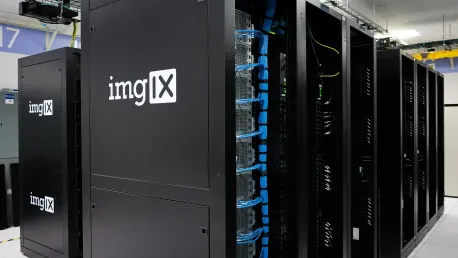The advent of the Internet of Things (IoT) is unleashing unprecedented changes in the data center industry. IoT’s integration introduces new paradigms in automation, predictive maintenance, and energy management. However, it also ushers in challenges associated with the massive influx of data and heightened security concerns.
The Surge of IoT Devices
The number of IoT devices continues to rise exponentially, transforming how data centers manage and store data. By 2024, 18.8 billion IoT devices were already in use globally. This figure is projected to reach 22.3 billion by 2030, highlighting the critical role of data centers in supporting this technology.
To handle the sheer volume of data generated by these devices, data centers are transitioning from traditional centralized models to more distributed or hybrid architectures. This change is essential for addressing real-time data processing needs. Distributed architectures allow data to be processed closer to the source, significantly reducing latency and enhancing overall system efficiency. This shift has been driven not only by the increase in IoT devices but also by the demand for faster, more reliable data processing.
As IoT devices proliferate, the strain on data storage facilities grows, requiring innovative solutions for data management. Edge computing, which processes data near its source rather than relying solely on centralized data centers, has become increasingly important. This approach helps in managing the vast amounts of data generated by IoT devices, ensuring that relevant information is processed quickly and efficiently.
Cloud and Edge Computing in IoT
Cloud migration offers numerous benefits for managing IoT data efficiently. It allows organizations to scale their operations, improve flexibility, enhance performance, and ensure robust data security while minimizing upfront hardware investments. By leveraging cloud infrastructures, businesses can handle the increasing amount of data generated by IoT devices without the need for constant hardware upgrades. This flexibility is crucial in maintaining the agility needed to keep up with evolving technological demands.
In tandem with cloud migration, edge computing is becoming crucial. By processing data closer to its source, edge computing reduces latency and optimizes the overall performance of IoT applications. The synergy of edge and cloud computing establishes a hybrid model that meets diverse IoT demands. This hybrid approach allows data centers to balance between centralized data storage and localized data processing, ensuring optimal performance and resource utilization.
Edge computing also helps in addressing the bandwidth limitations that come with transmitting large amounts of data to centralized servers. By processing data at the edge, only relevant and necessary information is sent to the cloud, reducing network congestion and improving the efficiency of data transmission. This localized processing not only enhances performance but also adds an extra layer of data security by keeping sensitive information close to its source.
Advanced Real-Time Monitoring
IoT enables continuous real-time monitoring in data centers, employing connected sensors to track metrics like temperature, humidity, air quality, and energy consumption. This capability significantly enhances operational efficiency, performance, and reliability. By constantly monitoring these critical parameters, data centers can quickly identify and address potential issues before they escalate into significant problems, ensuring smooth and uninterrupted operations.
Continuous data collection facilitated by IoT, when combined with predictive analytics and machine learning, helps automate and optimize data center functions. This approach not only boosts productivity but also provides real-time insights and improves security. Predictive analytics can forecast potential equipment failures or performance bottlenecks, allowing data centers to take proactive measures to mitigate these risks.
The real-time monitoring capability of IoT also plays a crucial role in maintaining the environmental conditions within data centers. By continuously tracking temperature and humidity levels, IoT systems can automatically adjust cooling systems to maintain optimal conditions, preventing overheating and ensuring the longevity of hardware. This level of automation reduces the need for manual intervention, freeing up resources for other critical tasks.
Automation and Predictive Maintenance
The automation capabilities brought about by IoT revolutionize data center operations. By leveraging real-time data, IoT systems can autonomously adjust cooling systems and optimize energy usage based on environmental conditions, ensuring maximum efficiency. Automated systems can respond to changes in workload and adjust power consumption accordingly, reducing waste and lowering operational costs.
Predictive maintenance powered by IoT minimizes equipment downtime and quickly identifies potential issues before they escalate. Machine learning models further enhance customer experiences and recognize data patterns, transmitting valuable insights for proactive measures. By analyzing historical data and identifying trends, predictive maintenance systems can accurately forecast when equipment is likely to fail, allowing for timely repairs and replacements.
The benefits of predictive maintenance extend beyond just preventing equipment failures. It also helps in optimizing the maintenance schedule, ensuring that interventions are performed at the most opportune times to minimize disruptions. This approach not only enhances the reliability of data center operations but also extends the lifespan of critical infrastructure components, resulting in long-term cost savings.
Cost and Energy Efficiency
IoT is instrumental in optimizing resource management within data centers. Real-time monitoring, coupled with predictive analysis, allows for efficient energy usage. IoT sensors ensure that electricity and cooling systems are utilized optimally, reducing waste and costs. By detecting and responding to fluctuations in demand, IoT-enabled systems can dynamically adjust power consumption, maximizing energy efficiency.
The growing adoption of renewable energy in data centers is facilitated by IoT. It aids in the seamless integration and management of solar, wind, and other sustainable energy sources, promoting eco-friendly operations and long-term cost savings. IoT systems can monitor the performance of renewable energy installations, ensuring that they operate at peak efficiency and contribute to the overall sustainability goals of the data center.
Energy efficiency is not only beneficial for reducing operational costs but also plays a critical role in minimizing the environmental impact of data centers. With the increasing focus on sustainability, data centers are under pressure to adopt greener practices. IoT-enabled systems provide the necessary tools to achieve these goals, allowing data centers to harness renewable energy sources effectively and optimize their energy consumption patterns.
Enhanced Security Measures
Security is a significant concern for data centers, and IoT provides solutions for both physical and cybersecurity. Connected devices like surveillance cameras and access control systems detect and respond to unauthorized access or suspicious activities promptly. These IoT-enabled security systems provide real-time monitoring and alerts, enhancing the overall security posture of data centers.
Advanced security measures ensure that data centers remain secure against physical intrusions and cyber threats alike, maintaining the integrity and safety of stored data. IoT devices can integrate with existing security infrastructure, providing additional layers of protection and enabling more comprehensive security strategies. By leveraging IoT technology, data centers can achieve a higher level of security, ensuring that both physical assets and sensitive information are protected.
In addition to physical security, IoT also enhances cybersecurity measures within data centers. IoT devices can monitor network traffic and detect anomalies that may indicate potential cyber threats. By analyzing patterns and identifying irregular activities, IoT systems can trigger automated responses to mitigate these risks. This proactive approach to cybersecurity ensures that data centers can stay ahead of emerging threats and maintain robust defenses against cyberattacks.
Future Trends and Agility
The IoT revolution in data centers is only just beginning. As IoT continues to grow, data centers will see further advancements in real-time monitoring, predictive maintenance, automation, and energy efficiency. These technologies will continue to evolve, offering new capabilities and driving innovation within the industry. Data centers must stay agile and adaptable to harness the full potential of IoT and stay competitive in the ever-changing technological landscape.
The continued adoption of cloud and edge computing will be pivotal in transforming data centers into dynamic and highly optimized systems capable of meeting evolving demands. Embracing these technologies will be essential for future success. As IoT device proliferation shows no signs of slowing, data centers will need to leverage cloud and edge computing to handle the increasing data volumes efficiently and maintain high performance.
The integration of IoT with other emerging technologies, such as artificial intelligence and machine learning, will further enhance the capabilities of data centers. AI-driven analytics will provide deeper insights into data center operations, enabling more informed decision-making and optimizing resource allocation. This synergy between IoT and AI will drive the next wave of innovation, making data centers more intelligent and efficient.
Sustainability and AI Integration
The arrival of the Internet of Things (IoT) is bringing revolutionary transformations to the data center industry. With IoT’s incorporation, we are seeing new frameworks in automation, predictive maintenance, and energy management emerge. These advancements have the potential to significantly enhance operational efficiency and reduce costs. However, the IoT era is not without its challenges. The enormous volume of data generated by interconnected devices leads to increased pressure on data storage and processing capabilities. Additionally, the complexity of securing these extensive networks of devices poses significant risks. Enhanced security protocols and robust data management strategies are essential for navigating the potential pitfalls. The data center industry must adapt to these changes by investing in infrastructure upgrades and embracing innovative technologies. As IoT continues to evolve, it will undoubtedly redefine the landscape of data centers, requiring a balance between leveraging its benefits while mitigating its challenges.









